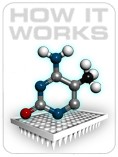人类乳腺癌基因甲基化PCR芯片 Breast Cancer EpiTect Methyl qPCR Array

人类乳腺癌基因甲基化PCR芯片 Breast Cancer EpiTect Methyl qPCR Array
“英拜为您实验加速” 技术服务网址:http://www.yingbio.com/ 服务热线:400-696-6643、 18019265738 邮箱:daihp@yingbio.com 、 huizhang1228@foxmail.com Breast Cancer EpiTect Methyl qPCR Array 人类乳腺癌基因甲基化PCR芯片 The Human Breast Cancer EpiTect Methyl II Signature PCR Array profiles the methylation status of 22 tumor suppressor gene promoters whose hypermethylation has been reported in the literature to occur frequently in a variety of breast tumors. Profiling tumor samples with these arrays may help correlate CpG island methylation status with biological phenotypes. The results may also provide insights into the molecular mechanisms and biological pathways behind oncogenesis and cancer pathology. With a simple restriction enzyme digestion and real-time PCR, research studies can analyze the methylation status of 22 different breast cancer genes with this DNA methylation PCR array. Both 96-well and 384-well ( 4 X 96 ) formats are available. 人类乳腺癌基因甲基化PCR芯片用于已经在文献中报道的各种各样的乳房肿瘤中经常发生甲基化的22个肿瘤抑制基因启动子的甲基化状态。用这些芯片分析肿瘤样本可能有助于关联CpG岛甲基化状态与生物表型。结果还可以助于洞察肿瘤形成和癌症病理的分子机制和生物学通路。利用这个芯片,通过简单的限制性内切酶消化和实时定量PCR,就可以研究分析22个不同乳腺癌基因启动子的甲基化状态。 Cell Cycle, Growth, Differentiation & Development:BRCA1, CCNA1, CCND2, CDKN1C, CDKN2A, SFN (14-3-3 sigma), TP73. Cell Adhesion:CDH1, CDH13. Transcription Factors:CDKN2A, ESR1, HIC1, PRDM2, RASSF1, TP73. Hormone Receptors:ESR1. Drug Metabolism:GSTP1. Apoptosis & Anti-Apoptosis:CDKN2A, PYCARD, TNFRSF10C, TP73. DNA Methylation:MGMT, PRDM2. Phosphatases:PTEN. Prostaglandin-Endoperoxide Synthase:PTGS2. Extracellular Matrix Molecules:ADAM23, SLIT2, THBS1. Proteases & Protease Inhibitors:ADAM23, THBS1. Ras Associated Protein Superfamily:RASSF1 工作原理: The EpiTect Methyl II PCR Array System relies on the differential cleavage of target sequences by two different restriction endonucleases whose activities require either the presence or absence of methylated cytosines in their respective recognition sequences. As real-time PCR quantifies the relative amount of DNA remaining after each enzyme digestion, the methylation status of individual genes and the methylation profile across a gene panel are reliably and easily calculated. The high yield of DNA from the restriction digests and PCR amplification allow the analysis of smaller, more heterogeneous samples. Download User Manual Tour the FREE Data Analysis Template
What It Offers:
You can easily perform an EpiTect Methyl II experiment in your own laboratory using any 96-well or 384-well real-time PCR instrument that you have access to. Array Layout: For more detail on PCR Array layout, see the "Gene Table" link for the individual array products. Data Interpretation
In the figure above, each horizontal bar represents the targeted region of a gene from one genome. Biological samples usually contain many genomes derived from many cell types. For simplicity, five such genomes are depicted here. Light and dark circles represent unmethylated and methylated CpG sites, respectively. Performance Data To verify the reliability of the EpiTect Methyl II PCR Array System, its results and sensitivity were compared with bisulfite Sanger sequencing, the gold standard in DNA methylation analysis Same Results as Bisulfite Sanger Sequencing
To validate the reliability of the system, EpiTect Methyl II PCR system results (EpiTect Methyl II PCR) were compared with bisulfite Sanger sequencing, the gold standard in DNA methylation analysis. The methylation status of the cadherin 13 (CDH13) gene promoter was analyzed using either bisulfite sequencing or EpiTect Methyl II PCR Assays in two different cell lines. EpiTect Methyl II PCR Assays revealed that 100% of total input DNA had methylated CDH13 gene promoter in MB231 cell lines whereas 100% of input DNA from HeLa cell line had unmethylated CDH13 promoter. Importantly, EpiTect Methyl II PCR Assays yielded results similar to Bisulfite Sequencing. Same Sensitivity as Bisulfite Sanger Sequencing
Primary tumors are typically very heterogeneous, containing a mixture of both cancerous and noncancerous cells. Therefore, reliable tumor characterization requires detecting smaller amounts of methylated DNA diluted in an unmethylated background. To test the sensitivity of EpiTect Methyl II PCR system to detect methylated DNA diluted in an unmethylated background, SKBR3 breast cancer cell line and normal blood genomic DNA (encoding methylated and unmethylated HIC1, respectively) were mixed in different ratios. EpiTect Methyl II Human HIC1 PCR Primers Assays were used to detect the methylation status of the mixed sample. Result show that the percentage of methylated HIC1 relative to total promoter DNA in each mixture was detectable even down to six percent of the total DNA sample showing the high sensitivity of EpiTect Methyl II PCR system. Application Data Gene promoter methylation is the most common epigenetic mechanism silencing tumor suppressor genes during oncogenesis. Almost all cancer-related signaling pathways are affected by methylation, and the number of genes affected in each major type of cancer is still rapidly growing. However, even the most relevant genes have not yet been correlated to individual cancer types or subtypes in order to better define biological pathways and mechanisms leading to oncogenesis and in order to properly develop DNA methylation biomarkers. The EpiTect Methyl II PCR System provides an ideal reagent for such studies, without bisulfite conversion of DNA. The following experiments demonstrate that EpiTect Methyl II PCR Arrays can both verify known and discover new DNA methylation cancer biomarkers
EpiTect Methyl II PCR Arrays are used to screen Breast Cancer Gene Methylation Status in Breast Cancer Cell Lines.The heat map compares the methylation status of 22 genes in the genomic DNA of three breast cancer cell lines and blood genomic DNA (used as an unmethylated control) determined with the Human Breast Cancer EpiTect Methyl II Signature PCR Arrays. The results further strengthen the correlation of these biomarkers with breast cancer. Biomarker / Pathway Discovery
EpiTect Methyl II DNA Methylation PCR Arrays Discover New Candidate Breast Cancer DNA Methylation Biomarkers. The heat map compares the methylation status of a panel of 79 transcription factor genes in six different breast cancer cell lines (some in duplicate) and a normal epithelial cell line as determined using 384-well EpiTect Methyl II Custom PCR Arrays. These breast cancer cell lines also methylate this gene panel potentially providing a new source of cancer biomarkers. These results are consistent with the notions that aberrant expression of transcription factors controlling cell differentiation plays key roles in oncogenesis and that transcription factors can be tumor suppressors. |














